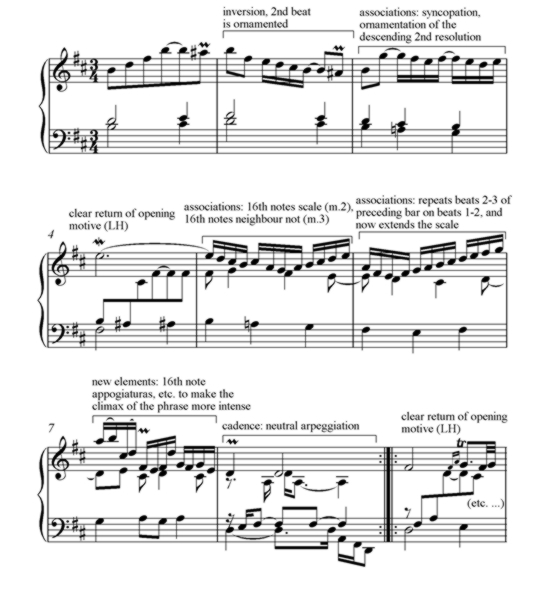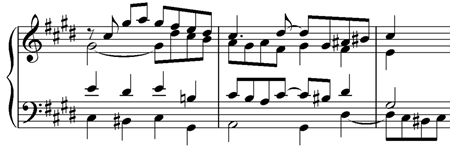Principles of Counterpoint – Line
Human perception seems incapable of paying attention to more than one strand at a time — perhaps an evolutionary adaptation to avoid confusion and to allow organisms to prioritize action? Although in some contrapuntal textures the listener’s attention migrates frequently between various parts, there is always a single focus at any given moment . In its broadest meaning, we will use the word “line” to refer to the main path followed by the listener’s attention through a musical work over time. If the composer does his work well, this path will be intriguing, coherent, and convincing from start to finish. This notion of one leading line is central not only to the study of counterpoint, but also to music in general.
In its more traditional sense, the “line” refers to the continuity in time of an individual melodic strand (usually referred to as a “voice”, or a “part”, in contrapuntal study). Let us examine some of the elements of line.
VOICE LEADING
Contrapuntal melodic strands can be seen as an outgrowth of basic harmonic voice leading. In the simplest block harmony, conjunct movement and tied common tones are the norm. This is because they are easy to sing — notes which remain in place or move by step are not hard to hear or find — and also because the ear tends to deduce continuity, in part, from common register.
Leaps by contrast are special events, used to renew interest, to open new registers and to attract the listener’s attention. In short, in a normal (conjunct) context, a leap acts as an accent.
CONTOUR
Contour refers to the shape formed by the successive pitches in a line. Changes of direction and, especially, extreme notes (top and bottom) are important events, memorable for the listener. In the case of lines which are vocal in inspiration, rising contour is associated with increased intensity, and falling contour is associated with relaxation. Developing a feeling for the balanced rise and fall of tension in a melodic line is a good preliminary step towards a sense of form.
COMPOUND LINE
In “compound line”, a melody is enriched by frequent leaping between two or three registers, giving the illusion of two or three simultaneous levels, although there is actually never more than one note sounding at a time.

Here the melody implies voice leading in 3—4 parts, as portrayed on the lower staff. Note that active notes are resolved normally in the next harmony. Unresolved active tones would create distraction.
Compound line is based on the strong association between continuity and register, and can allow a single instrument to supply all or some of its own harmony. It creates implicit continuity between notes that are not adjacent in time. The most exuberant examples of this technique are of course the solo violin and cello suites of Bach.
ACCENT
Accent is an important property of line, since not all the notes in a given line are of equal importance. Highlights and contrasts provide interest and richness, creating a more interesting profile.
Accent is not limited to normal metric stress. Accent can also result from:
- agogic accent (accent by duration). This is the normal accent in Renaissance music, wherein barlines were not used to define meters. Renaissance polyphony, for all its impressive euphony, is rich in accentual conflict when properly sung, since long notes arrive independently in each part.

Each note which starts a slur here would be lightly accented, creating an interesting independence of accents between the two parts.
- extreme pitch, especially high points

Here the high F, despite its weak metrical position, would be sung with a certain intensity, mitigating metrical squareness.
- striking harmony

In this example, after a melodic peak on the high A after the third beat, the Neapolitan harmony on the last beat creates a harmonic accent.
One of the most important aspects of linear independence is independence of accent. Even when all lines use the same note values, they will not normally have entirely coordinated accents. Coordinated accents are a strong sign to the listener that something special is happening, usually a climax. When previously independent strands begin to follow the same contour at the same time, the effect is one of simplification, clarifying momentum for the listener, and increasing the music’s drive. Used well, this is a powerful cue that culmination is approaching. Used poorly, it destroys tension: If the expected climax does not materialize, the effect can be disappointing.
Accent is related to harmony: Notes which belong to the prevailing harmony are perceived differently from those which clash with it. Notes between chord tones create tension and keep the music alive until the next harmonic arrival point.
MELODIC STRUCTURE AND ORNAMENTATION
In most western music, contrapuntal lines meet fairly regularly to form recognizable chords, usually at metrical accents. These meetings act as harmonic pillars. The gaps between them, when the lines move more freely, create both a sense of freedom and of tension, since they normally include at least some notes outside of the prevailing harmony. (If they regularly include nothing but chord tones — as repeated notes or arpeggios — they are better understood as harmonic elaboration and not as linear development.)
While it would be impossible to list all possibilities exhaustively here, we can categorize idioms of melodic elaboration into a few main types:
- conjunct passing notes
- neighbor notes
- indirect approaches, including changes of direction and 8ve displacements

Underlying the melody in this example is a simple rise from C to G. The line gains interest from the varying ways in which this skeleton is fleshed out, and especially from the climactic “overshoot” between the F and the final G. This “detour” has the effect of making a second approach to the G, from above, delaying the primary one, from below.

This example features the very common technique of octave displacement. This maneuver allows the line to stay within one singable register, and avoids the overly dramatic effect of a long scale rushing down.
- combinations of steps, which create melodic flow, and leaps, to open up new registers and renew interest.

Here the leap at the end of measure 2 adds interest after the simple scale and neighbor motions which precede it. The neighbor note on the high C softens the melodic fall after the peak on D.
- moving a line out of phase with the prevailing harmony (suspensions).

Suspensions are one of the oldest of dissonance formulas; they result from the fact that it is easier for a singer to vocally “find” a dissonant note if it is already sounding (in the previous harmony) as a consonance.
Some of these categories correspond to the species of traditional contrapuntal pedagogy: This is another argument for using the species approach, as long as it is applied with intelligence and flexibility.
MOTIVES AND COHERENCE
Motives can add an extra dimension to linear coherence. A motive is a short, memorable pattern, which is repeated and varied. Usually motives are melodic/rhythmic patterns (although in Mahler’s 6th Symphony, the change from a major to a minor triad accompanied by cross—fade orchestration is clearly an important “motive”). Such patterns create associative richness. Motives stimulate the memory, and thus create connections that go beyond simple short—term continuity. Conversely, introducing a characteristic motive and then ignoring it usually creates distraction and weakens the overall effect.
Dissonance formulas, apart from the most basic ones (passing and neighbor notes in neutral rhythm), in effect create motives requiring continuation.
The standard ways of using motives are listed in many texts and need not be detailed again here. However one distinction we have found useful is between “close” and “distant” variants of a motive. The frequent repetition undergone by most motives requires more or less continual variation to maintain interest. The key point is whether an attentive listener is more struck by the novelty of a given motivic transformation or the association with the original. Certain motivic variants, for example retrograde, and augmentation/diminution, especially in cases where these upset the rhythmic flow, may be easily noticed visually, but when heard are often quite dissimilar to the original form.

Here the retrograde sounds nothing like the original motive, due to the syncopated rhythm it creates. It sounds more like an intentional contrast then a simple continuation.
There is one special case which needs discussion here. Bach sometimes uses progressive ornamentation of a motive in the course of a section. (This is the basis for what Schoenberg calls the technique of “developing variation”, and in fact he bases most of his theory of musical form on it.) As in the children’s game, where each person whispers a message to his neighbour and where it eventually gets distorted beyond recognition, this kind of development can quickly lead the listener very far afield. There are three basic principles which govern coherence in this situation:
- Each new version of the motive must be easily recognizable as an ornamentation / variation of the preceding version. In fact, often Bach will add extra associative elements to make the connection easier.
- The variants must be close in time.
- After several progressively more distant variants, Bach will return to a much closer variant in a very prominent place.
Here is an example, with analysis, of Bach’s procedure.

In summary, the composer needs to carefully control whether the degree of association or novelty created is appropriate to the context. For example, a short section of just a phrase or two is very unlikely to require the kind of far—flung contrast that retrograde usually engenders. On the other hand, if the composer wants to create a contrasting theme out of previous material, retrograde can be useful.
NEUTRAL LINES
A common misconception in writing motivic counterpoint is that everything must be derived from the motives in the theme. Not only is this demonstrably untrue in much fine music, often it doesn’t even make musical sense. While motivic “tightness” certainly can contribute to a coherent musical flow, it can be present in varying degrees (ranging from the tightest canonic imitation to the kind of much looser texture found in many fugal episodes, where one leading part is accompanied by more neutral counterpoint). Indeed, there is sometimes a distinct advantage to using more neutral material, of the sort found in elementary species work. Simple conjunct movement and suspensions are useable, in virtually any contrapuntal context, without drawing attention to themselves, whether or not they are present in the work’s original thematic material. These simple resources often better highlight important ideas than would the competing presence of other, more distinctive motives.
One useful technique for reducing the density of contrapuntal textures without losing the independent interest of each line is to stagger rhythmic doubling: several parts can share rhythmic values, as long as they don’t consistently begin and end their rhythmic doubling together.

Here the alto goes into eighth notes after the soprano has already started them, and continues after the soprano has stopped. The bass and tenor start off together in quarter notes but change in measure 2 to different values. Thus the texture remains transparent, but no two lines ever go for long in rhythmic unison.
